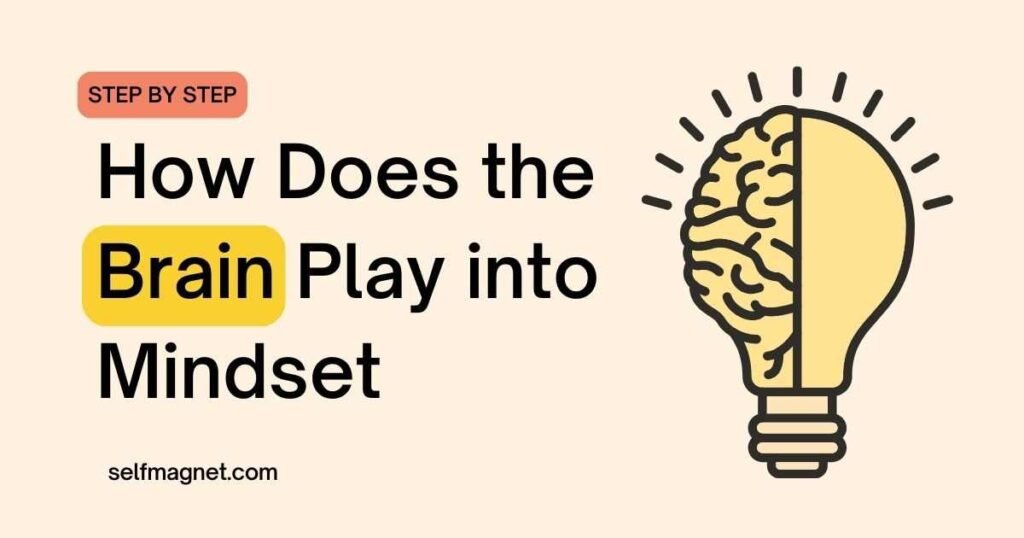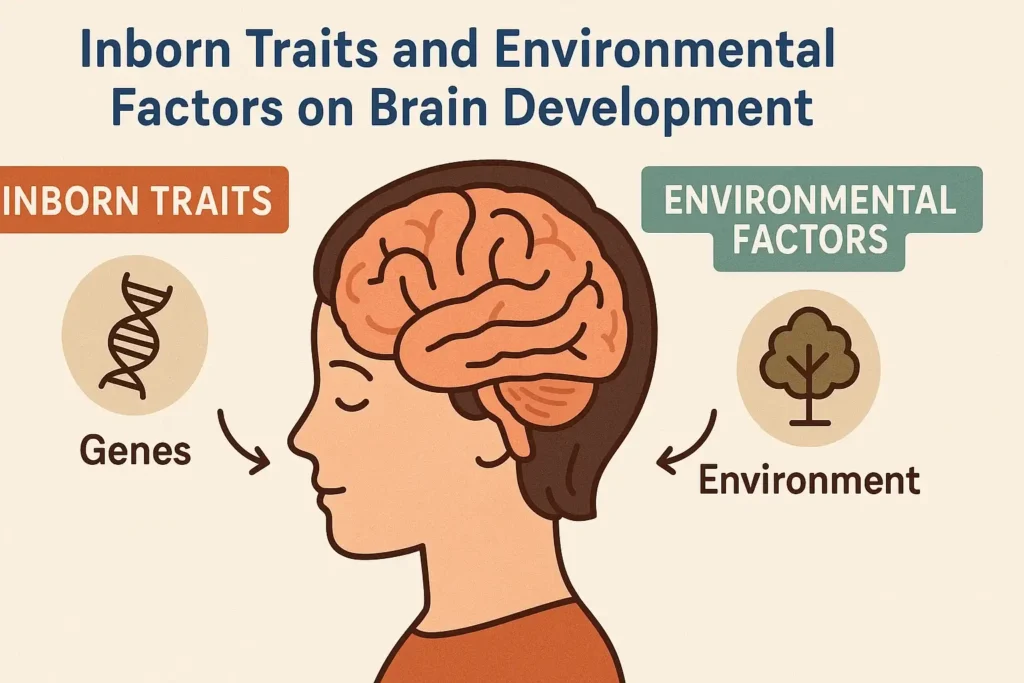Do you ever wonder why some people flourish in hardship while others suffer? The answer lies not merely in talent or circumstance but in the complex play between the brain and mindset. So, how does the brain play into mindset?
The brain forms neural pathways that guide our thoughts, emotions, and behaviors. Experiences, learning, and habits either strengthen or rewire these pathways.
Understanding brain flexibility, neurotransmitters and how our traits interact with the environment helps build a positive mindset and personal growth.
This article invites you to explore the fascinating bond between the brain and the mindset. In this enlightening journey, we’ll also reveal how the brain influences our perspectives. Let’s begin!
Understanding Mindset: A Foundation

What is Mindset?
Mindset is a collection of beliefs about yourself and your abilities that affect how you think, feel, and act. Think of it as a filter that colors your self-perception and worldview.
Experiences, upbringing, education, and personal choices can govern mindsets. They are crucial in determining one’s approach to challenges, opportunities, relationships, and well-being.
There are different mindsets, such as a growth mindset and a fixed mindset.
Each designs our thoughts and responses differently.
Here’s a table highlighting the difference between a fixed mindset and a growth mindset:
| Aspect | Fixed Mindset | Growth Mindset |
| Definition | Perceives intelligence, talents, and abilities are permanent and unchangeable | Believes that talents, intelligence and skills can be acquired through work, commitment, and education. |
| View on abilities | Assumes abilities are fixed and cannot be improved through effort or learning. | Considers abilities can be developed through effort, learning and dedication. |
| Approach to challenges | Avoids challenging tasks out of fear of exposing limitations. | Views obstacles as opportunities for exploration and growth, not barriers to success. |
| Effort perception | Consider effort baseless if not naturally good at something. | Values hard work and persistence as essential for personal and skill development. |
| Feedback response | Takes feedback as an attack on wisdom, leading to defensiveness or avoidance. | Embraces feedback as a tool for refinement and improvement. |
| Comparison orientation | Asses self-worth against others, causing envious or competition. | Focuses on personal progress, not just perfection, encouraging partnership and supporting relationships. |
| Effects on potential | Limits potential for prosperity by believing in fixed abilities. | Trusting in the capacity to thrive opens door to success, resulting in the enlarged scope. |
| Resilience to setbacks | Setbacks and failures are seen as permanent limitations, spurring discouragement and giving up early. | Setbacks and failures result in improved grit, fostering enhanced resilience and motivation. |
| Motivation Orientation | Fear of failure hampers motivation, particularly with challenging tasks. | Highlights learning and refinement, fueling intrinsic motivation and a love for facing difficulties. |
| Impact on relationships | Constant comparison and fear of judgement can harm rapport. | Future-oriented mindset promotes collaboration, building supportive and interpersonal ties. |
Deep Dive into the Fixed Mindset:

A fixed mindset is an ideology that perceives intelligence, talents, and abilities as permanent and unchangeable.
This mindset type holds that you’re born with a certain capability in each area that can’t be improved through effort or learning.
Some key traits of a fixed mindset are:
- Fixate on outcomes: Success requires perfection; failure implies a lack of ability.
- Fear of challenges: People with a fixed mindset avoid challenging tasks out of fear of exposing their limitations.
- Discourages effort: People think it’s pointless to try if you’re not naturally good at something.
- Sensitive to feedback: People often take feedback as an attack on their intelligence, causing defensiveness or avoidance.
- Comparison-centric: Measuring self-worth against others breeds envy or competition.
Fixed mindset effects:
- Limits potential: Believing in fixed abilities limits the potential for prosperity.
- Hinders resilience: Setbacks and failures are permanent limitations, leading to discouragement and giving up easily.
- Dread of failure: Fear of failure hampers motivation, particularly with challenging tasks.
- Damaged relationships: Constant comparison and fear of judgment can spoil relationships with others.
Expanding Horizons: The Power of a Growth Mindset
Unlike the fixed mindset, the growth mindset believes that intelligence, talents, and skills can be acquired by work, commitment, and education.

Carol Dweck is a renowned psychologist famous for her work on the concept of a “growth mindset.” Her book “Mindset: The New Psychology of Success,” addresses the idea that people with a growth mindset can learn and grow through work and determination.
Key characteristics of a growth mindset:
- Focus on learning: Setbacks are opportunities for exploring and growth, not barriers to success.
- Effort is valued: Hard work and persistence are essential for expansion.
- Open to feedback: Embrace feedback for refinement.
- Face struggles: Hard tasks help develop new skills.
- Growth-oriented motivation: People seek progress, not just perfection.
Benefits of a growth mindset:
- Increased potential: Trusting your capacity to thrive opens doors to success.
- Enhanced resilience: Setbacks and failures lead to increased perseverance.
- Greater motivation: Highlighting knowledge and refinement fuels intrinsic motivation and a love of adversities.
- Better interpersonal ties: Future-oriented people are collaborative and supportive.
The fixed mindset is not permanent. People can have fixed or growth mindsets depending on the situation or realm.
Strive for an evolving outlook.
Cultivating a growth mindset
- Question your internal dialogue: Align empowering affirmations with restrictive ideas.
- Celebrate effort and maturity: Prioritize training, not just the end result.
- Meet trials: Take risks and utilize hurdles for your benefit.
- Take input: Get helpful input to advance and gain.
- Zeroing on Education: Engage in activities that stimulate your curiosity and expand your knowledge base.
An advanced mentality is a lifelong process. With dedication and self-awareness, you can reach your full potential and appreciate a lifelong love for self-fulfillment. You prefer self-admiration.
Let’s break down the concept of mindset from a neuroscience perspective.
How Does the Brain Play into Mindset: The Brain-Mindset Nexus

Have you wondered why some people breeze through life, facing problems with a smile, while others suffer under even the slightest pressure?
The answer lies not in some fate but in the harmony between your brain and your mindset.
Neuroscience reveals that mindset isn’t just a personality trait—it’s a biological process we can rewire.
But how exactly does the brain relate to mindset? Let’s break it down.
The Brain & Mindset: A Dynamic Duo
The brain controls thought patterns, habits, emotions, and more as a complex processing center through an interconnected web of neurons.
Picture your brain as a lively orchestra with interconnected neurons firing electrical signals and processing information.

Neural pathways strengthened by emotions, genetics, and life events determine how we perceive and respond to various situations.
The prefrontal cortex, limbic system, and brain chemicals work together to shape our thinking habits, reinforcing either a mindset of growth or one that stays fixed.
Over time, these pathways become more efficient, controlling your decisions, actions, and, yes, your mindset.
People also read:
How to Reprogram Your Subconscious Mind to Manifest Your Dreams
I can’t be alone with my thoughts: Overcoming challenges and finding comfort
The Role of the Prefrontal Cortex
The prefrontal cortex (PFC) acts as the brain’s control center, governing:
- Decision-making and critical thinking – It helps evaluate options, weigh consequences, and make informed choices.
- Goal-setting and motivation – The PFC drives persistence, helping individuals stay focused on long-term objectives.
- Emotional regulation and impulse control – It manages emotional responses, preventing rash decisions and fostering resilience.
A well-developed PFC supports a growth mindset, enabling individuals to embrace challenges and adapt.
In contrast, a weaker or underactive PFC fosters cognitive rigidity, reinforcing limiting beliefs and resistance to change.
Strengthening this region through mindfulness, problem-solving, and continuous learning can improve mental flexibility and resilience.
Neuroplasticity: The Brain’s Adaptive Power

Neuroplasticity is the brain’s amazing power to change and adapt throughout life. It is responsible for shaping and reshaping our mindset throughout life. Your brain is not some fixed object.
Think of it like a flexible and dynamic network of roads in your brain. When you imbibe something new or encounter different things, it’s like building new paths or intensifying existing ones.
This flexibility allows your brain to recover from injuries, improve skills, and adjust to new situations. It forms the network of mental and conduct trends that make up a person’s outlook and reactions.
So, just as you can upgrade and modify a computer’s software, your brain has its way of rewiring itself based on what you do, master, and endure.
Neuroplasticity is the reason why you can continue to hone and rise, no matter your age. You can actively sculpt your neural circuits by consciously creating new frameworks.
Your brain alters and grows stronger with the effort you put in.
But many find old pathways quick to reactivate. Success requires awareness and repetition.
Fixed mindset thinking is associated with rigid neural connections. You tend to stick to familiar routes, skipping hurdles because you believe you can’t change much.
Let’s explore the various forms of neuroplasticity, like synaptic plasticity and structural plasticity. Understanding these distinctions provides a deeper insight into how the brain evolves.
Neural connections form the elaborate communication system known as synapses within the brain. It enables the transmission of signals between neurons, facilitating the exchange of information. As people acquire new information or follow different pursuits, these neural links refine and fortify synaptic plasticity.
Structural plasticity refers to the ability of the brain’s neurons (nerve cells) to change their physical structure gradually. It involves modifications in the actual structure of neurons and their connections.
Imagine the brain as a vibrant city with a network of roads (neuronal connections) joining different localities (brain regions).
When you gain or observe something new, structural plasticity allows the creation of new roads, remodeling existing ones, or even forming fresh spaces.
This flexibility helps us to absorb from memory, navigate difficulties, and recover from injuries.
The table below summarizes the difference:
| Aspect | Synaptic Plasticity | Structural Plasticity |
| Definition | Changes in the strength of existing connections (synapses) between different neuron. | Changes in the physical structure of neurons and their connections. |
| Focus | Emphasize the efficiency of communication at specific synapses. | Focuses on the physical remodeling of neural architecture. |
| Nature of Change | Involves strengthening or weakening of existing connections. | Involves the formation of new connections or the alteration of existing ones. |
| Time Scale | Often occurs relatively quickly, within minutes to hours. | Can take longer and involves more long-term structural modifications. |
| Functional Implication | Immediate impact on neural communication and learning. | Influences the overall wiring and organization of the brain. |
| Example | Acquiring a new skill, short-term memory formation. | Brain development during childhood, recovery after brain injury. |
This table provides a simplified comparison between synaptic plasticity and structural plasticity.
Purposeful rewiring through neuroplasticity can slowly transform neural structures and the resulting mindsets.
Practical Tips for Promoting Neuroplasticity:
There are evidence-based practices you can incorporate into your daily life to promote neuroplasticity:
- Stay Curious and ingest something new: Keep your mind active by exploring new things and being curious. Like, dive into a new language, musical instrument, or a dance style. This keeps your brain flexible.
- Do puzzles and brain teasers: Sudoku, crosswords, logic puzzles, and brain training apps can provide a playful mental workout, stimulating neuron growth and cognitive function.
- Regular exercise: Most days, exercise moderately for 30 minutes. Aerobic activities like running, swimming, or cycling enhances blood flow to the brain and promote neurogenesis (birth of new brain cells) and overall brain health.
- Balance and coordination: Activities like yoga, tai chi, or dancing challenge your brain to integrate sensory information and coordinate movements.
- Balanced and Healthy diet: Start with a balanced diet of fruits, vegetables, omega-3s, and antioxidants.
- Stay hydrated: Water is vital for all bodily functions, including brain health. Dehydration can impair cognitive performance and hinder neuroplasticity.
- Restful sleep: Get adequate quality sleep. Your brain heals itself, clears out toxins, and blends memories as you sleep.
- Practice mindfulness and meditation: These techniques boost attention, lower stress levels, and increase cognitive flexibility.
- Socialize and connect: Interacting with others stimulates various parts of the brain. It stimulates brain activity and builds up social cognitive skills.
- Juggling or playing juggling games: Engaging in activities that require hand-eye coordination and spatial awareness can stimulate new neural pathways.
- Sensory Deprivation: Occasionally witness sensory deprivation, like floating in a sensory deprivation tank. Depriving your senses can lead to increased neural activity and creativity.
- Change Dominant Hand: If you’re right-handed, use your left hand for daily tasks and vice versa. This challenges your brain to adapt to new motor skills and strengthens neural connections.
Remember, consistency is key! While a single activity won’t magically enhance your brainpower, incorporating these practices into your daily routine can contribute to a healthy and adaptable brain over time.
The effectiveness of specific practices may vary depending on individual factors.
Consult a healthcare professional for tailored guidance.
Neurotransmitters and Mindset Regulation

The brain uses neurotransmitters to regulate mood, emotions, and overall mindset.
| Neurotransmitter | How It Affects Mindset |
|---|---|
| Serotonin | Boosts mood and happiness. Keep it balanced through light, exercise, and good food. |
| Cortisol | Helps handle stress but too much can drain you. Manage with movement, rest, and a positive mindset. |
| Dopamine | Drives motivation and reward. Set small goals, stay curious, and keep learning to fuel it. |
| Oxytocin | Builds trust and bonding. Increase it with hugs, kind acts, and quality time with others. |
Now, let’s take a closer look at each neurotransmitter, starting with serotonin, the feel-good messenger.
Serotonin and the Feel-Good Mindset
Serotonin, known as the “feel-good” neurotransmitter, regulates mood and emotions.
Balanced serotonin levels contribute to feelings of contentment and happiness.
Imbalances may be linked to mood disorders.
So, maintaining a healthy serotonin balance through exercise, natural light exposure, and a nutrient-rich diet is essential for a bright outlook.
Cortisol and Stress-Induced Mindset
Cortisol, known as the “stress hormone,” is a hormone that helps you cope with stress.
It helps us deal with obstacles, but too much for too long can mess with our mindset.
Prolonged exposure disrupts memory and sleep and contributes to anxiety and depression.
Exercise frequently and practice mindfulness as a stress-reduction strategy.
How you take stress (‘challenge’ or ‘threat’) also affects your endurance of dealing with it.
Dopamine and the Urge to Work
Dopamine is a brain chemical that helps with motivation, learning, and mood.
It acts like a messenger, sending signals between brain cells to drive action.
When you achieve something, dopamine gives you a sense of reward, making you want to keep going.
It also helps you learn by strengthening brain connections.
Balanced dopamine levels boost motivation, and curiosity.
On the other hand, low dopamine can lead to lack of drive, fear of challenges, and sticking to comfort zones.
You can naturally increase dopamine by setting goals, exercising, socializing, and learning new things, helping your brain stay flexible and adaptive.
Oxytocin for Trust and Connection
Oxytocin is often called the “bonding hormone.”
It helps build trust, connection, and emotional safety.
It binds relationships by making social interactions more rewarding.
Higher oxytocin levels encourage openness, empathy, and collaboration.
When you feel secure in your relationships, you’re more likely to embrace new ideas, take risks, and learn from others.
Low oxytocin, however, can lead to social withdrawal, fear of judgment, and resistance to change.
Simple actions like hugging, deep conversations, helping others, and practicing gratitude can naturally boost oxytocin.
We’ll look at the built-in traits and outside forces.
Inborn traits and Environmental Factors

Genetic Component of Mindset
Understanding how genetics and epigenetics relate can help us better understand how complex mentality formation is and provide potential directions for interventions that support mental wellness.
Epigenetics studies changes in organisms produced by gene expression rather than genetic code alteration.
Imagine your genes are like a big instruction book for your body. Epigenetics is like little bookmarks and highlights in that book.
They don’t change the words (genetic code). But they tell which parts to pay attention to, and those choices can inspire how you sense and feel.
Here’s how it works:
- Things you go through can leave these “bookmarks” on your genes. It’s like underlining certain instructions in the book.
- Those bookmarks can turn some genes “on” or “off,” even though the words stay the same. This can influence your mindset, making you more optimistic, for example, or more prone to worry.
- The cool part? These bookmarks aren’t permanent! You can create new ones through new risks and choices. This means you can change how your genes are expressed and, to some extent, your mindset.
So, even though you inherit genes from your parents, epigenetics shows you’re not stuck with a fixed script. You can be the author of your own story.
Environmental Factors
Genetics provide the basis, but environment and experience may regulate gene expression. While past episodes provide a foundation, the environment directs inclination during adulthood.
Workplace dynamics, social relationships, and community interactions all nurture individual perspectives, responses, and mindsets. Office cultures can encourage you to tackle problems and learn from failures.
Likewise, social groups that offer support and varied viewpoints aid in continuously evolving one’s thought process.
Conclusion
In conclusion, the interplay between our mindset and brain is exciting. Mindset, convictions, and values influence how we perceive and respond to challenges. Understanding fixed and growth mindsets reveals the power of our beliefs in forming our aptitude.
Looking at the brain from a neuroscience perspective, it’s like a dynamic orchestra controlling thoughts and behaviors.
The prefrontal cortex (PFC) helps guide behavior, influencing how we plan, adapt, and handle challenges.
Neuroplasticity, the brain’s adaptability, allows us to enhance our mindset throughout life by forming and strengthening neural connections.
Practical tips for promoting neuroplasticity include staying curious, engaging in mental challenges, exercising, maintaining a balanced diet, getting enough sleep, practicing mindfulness, and fostering social connections.
Neurotransmitters also play a role.
Balanced serotonin contributes to a positive outlook while managing cortisol is crucial for mental well-being.
Dopamine derives motivation. Oxytocin deepens trust and connection.
Genetics provides a base, but experiences and choices can shape our mindset. Environmental factors, like workplace dynamics and social interactions, contribute to our continuous growth
How does the brain play into mindset highlights our remarkable potential for personal development and upgradation.
By understanding the connection between beliefs, brain functions, and our environment, we can be actively mature and thrive despite failures.
FAQ
Additional Resources
For those eager to research deeper, the following resources provide additional insights:
- Carol S. Dweck – Mindset: The New Psychology of Success
- Rick Hanson – Hardwiring Happiness: The New Brain Science of Contentment, Calm, and Confidence
- Richard J. Davidson & Daniel Goleman – Altered Traits: Science Reveals How Meditation Changes Your Mind, Brain, and Body
- 6 Ways to Enhance Neuroplasticity and Learning in Early Childhood Years